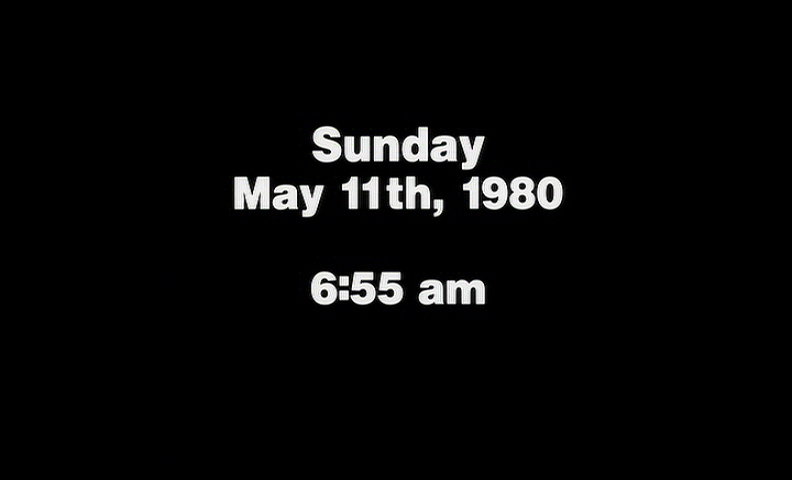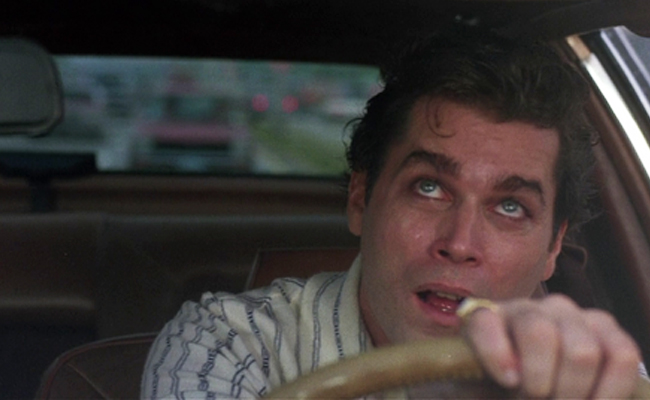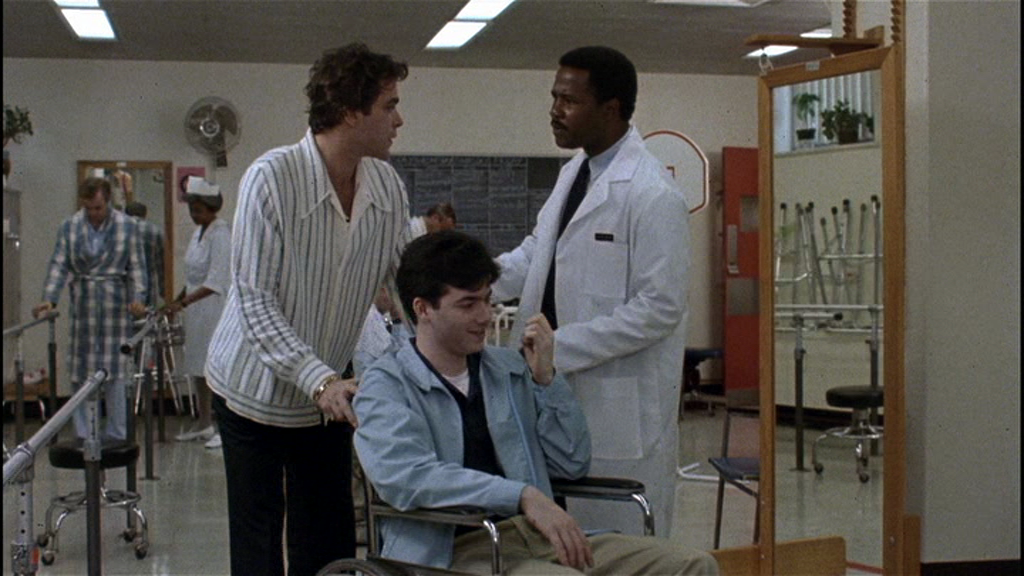
Today is Monday, May 11th, 2020. 40 years ago today was Sunday, May 11th, 1980, also known as Henry Hill’s terrible horrible no-good very bad day in Goodfellas. In reality, Hill was arrested a few weeks before May 11th, and the film just chose to relocate the date. Why? Because it’s Goodfellas, a film that can do whatever it wants simply in the name of being Goodfellas. It’s a movie that can randomly change the date of an event it portrays and have people marking the made-up day instead of the real one three decades after its release. It’s a movie that can create an indelible moment celebrated by fans out of white text on a black background and the first few notes of a Harry Nilsson song. The May 11th sequence in Goodfellas is the stuff of legend because it’s so good and because it’s a microcosm of the entire movie’s bravura filmmaking and magnificently entertaining construction. It’s Martin Scorsese’s finest moment as a director, Thelma Schoonmaker’s finest moment as an editor, and Harry Nilsson’s best moment as a contributor of music to films (sorry, Borat. And I guess Midnight Cowboy). So in honor of Goodfellas day, helicopter day, lucky hat day, or whatever other monikers may be applied to it, here’s a deep dive into one of the most incredible scenes in the last 30 years of film.
As I have mentioned many, many times on this blog, Goodfellas is my single favorite movie. Any assessment I make of it is rooted first and foremost in the fact that it’s an important film to me personally, so take my opinion here with a proper consideration of that bias. With that said, it’s objectively unquestionable that Goodfellas is the single most important work of American art since the inception of the country. It’s narratively flawless. It’s impeccably acted. It’s put together with the assurance of a master creating his masterpiece and loving every minute of it. This is the pinnacle of what popular art can be. In the ensuing decades it’s become harder to find something this publicly adored that’s made with this level of audacity, a trend that Scorsese himself has lamented to endless controversy. Goodfellas runs for 2 hours and 25 minutes and every single one of them is necessary and entertaining. But about 10 of these stand apart from the rest in terms of quality and continued prevalence. Enough introduction. Let’s talk the major players in this scene:
Ray Liotta

The May 11th sequence stands apart from the rest of Goodfellas in an interesting way: the main character is really at the forefront. For most of the film, Liotta’s Henry Hill is certainly a major presence, but his role is much more subdued than the grandstanding work done by Joe Pesci and Robert De Niro, he exists as an observer, the audience’s gateway into his world. Sure, he’s a pretty active member of the plot and he’s in almost every scene, but he’s rarely at the center of the action. But on the morning of May 11th, Hill steps behind the wheel of his car and Liotta finally gets to show off. His voiceover accompanies the scene as it has for the whole of the film, and here it works perfectly to guide the viewer through what’s going on in a way that fits the scene’s rushed tone. But Liotta’s on-screen acting here is the best it gets. The scene on his part consists of staring into the sky and looking very sweaty, and he absolutely nails it in ways that shouldn’t even be possible. He’s the embodiment of drugged-out paranoia. Every glance up at the possibly nonexistent helicopter is sold brilliantly, and while a lot of credit has to go to the makeup department for delivering on the requisite look for the scene, Liotta delivers the behavior to match it. If Goodfellas is to be taken as the story of the rise and fall of Henry Hill, you need to really make the fall spectacular, and he does.
Thelma Schoonmaker

Thelma Schoonmaker is the greatest editor in film history, a fact sure to displease everyone who complained about the length of The Irishman without having any understanding of what a film editor actually does. She edited Scorsese’s debut feature, Who’s That Knocking at My Door in 1967, and has cut all of his films since Raging Bull in 1980. Raging Bull is often cited as her best work and put up as a candidate for the best–edited film of all time, but (biased as I am) I would argue that it’s Goodfellas that deserves those honors. The May 11th sequence is a perfect demonstration of why: while Raging Bull‘s fight sequences are put together with a brutality and skill that immerses the viewer in the fight, this is a scene that’s cut in a way that puts you in Hill’s coked out shoes. The editing in this scene is visionary, and perhaps the greatest disproof of the rule that the best editing is invisible. This is flashy and out-there work, and it 100% works.
Martin Scorsese

Well, obviously. Scorsese, being the film’s director, clearly had a lot of influence on this scene, and it deserves to be said that it remains the best thing he’s ever done. Sure, the tracking shot through the back of the Copacabana (also in Goodfellas because of course) is a strong contender, and Taxi Driver‘s iconic “You talkin’ to me?” speech is a classic moment, but for my money this takes the cake. You could make a case for Leonardo DiCaprio’s extended crawl to his car in The Wolf of Wall Street or the LaMotta-Robinson fight in Raging Bull, but I believe that this is it. Although you could claim… screw it. Here’s a list of some great moments in Martin Scorsese’s movies that still aren’t as good as this one.
- The opening 20 minutes or so of The Departed where like the entire first act happens in one long montage and then after that whole thing the title card finally appears
- The final scene of Shutter Island
- The pool hall fight in Mean Streets
- “I’m not leaving”, Wolf of Wall Street again
- Griffin Dunne seeing a murder through a window in After Hours and defeatedly declaring “I’ll probably get blamed for that”
- De Niro’s frenzied laughing in Cape Fear
- Al Pacino nonchalantly raising the flag back up to full mast after JFK’s death in The Irishman
- The rat in The Departed. Fight me.
Sorry about that. Back to the thing I was actually writing.
The soundtrack

The way I see it, there are four things that make this scene work so well. The first three (Liotta’s performance, Schoonmaker’s editing, and Scorsese’s direction) I’ve already mentioned. The fourth is the music. The frantic deployment and constant changing of songs is part of what makes this so iconic, and the songs all fit the tone perfectly. A quick walkthrough:
Jump Into the Fire by Harry Nilsson- Nilsson’s name is the one I’ve mentioned the most times in this post, and he’s also the guy who gets the photo at the head of this section. That’s because this song is the clear MVP of the scene: the opening notes play over the title card, and it comes back in after other songs at two more points in the scene. It has become synonymous with the sequence, it’s impossible not to think of the film every time it’s in a commercial or heard elsewhere. Outside of the “Layla” cue, it’s maybe the most famous use of music in the movie.
Memo from Turner by The Rolling Stones- my tidbit on this one is that Scorsese really likes The Rolling Stones. More on that in a bit.
Magic Bus by The Who- this is a live version of the song, which apparently runs over eight minutes. (Not even trying comedian voice) “wow, that’s so long it might as well be The Irishman!”
Monkey Man by The Rolling Stones- much has been made of Scorsese’s use of “Gimme Shelter” in his gangster films (it appears in Goodfellas, Casino, and The Departed) but “Monkey Man” pulls off what that song could not and shows up twice in the same movie. This is the second occurrence of the song in the film. Other uses of Stones songs in Scorsese’s work include “Jumpin’ Jack Flash” in Mean Streets, “Sweet Virginia”, “Heart of Stone”, and “Can’t you Hear me Knocking” in Casino, and quite a few of their songs in Shine a Light, the 2008 concert movie he directed for them.
What is Life by George Harrison- pretty much the lone basis for my idea that Harrison actually had the best solo career of any ex-Beatle.
Mannish Boy by Muddy Waters- I have nothing to add here beyond saying that the man’s dedication to classic rock is astonishing.
Other random stuff

I’ve hit the major aspects of the scene, and limited myself to only 2 diversions where I just started listing stuff from Scorsese movies. So to close out my look back on the scene, here’s some random stuff about it.
- The doctor in the above image, who wants to check out Henry and make sure he isn’t about to drop dead, is played by Isiah Whitlock Jr, who later became famous for his portrayal of corrupt politician and profanity artist Clay Davis on The Wire.
- Welker White plays Lois Byrd in this movie, the babysitter who foolishly calls from the house phone and can’t fly without her lucky hat. In The Irishman, she plays Jo Hoffa, who receives a phone call from De Niro’s character in one of that film’s best moments (This is a tremendous reach of a connection but I can’t really just say “she was in both movies” so this is what I settled on).
- Apparently Scorsese knew how he wanted to use specific songs from the film years before he made it, which could go a long way towards explaining why there are so many in this sequence: he wanted to fit as many in as possible.
- The federal agent at the tail end of the scene explaining witness protection to Henry and Karen was played by the real US attorney who dealt with Hill, who improvised his “Don’t give me the babe in the woods routine, Karen” line
- One of Scorsese’s rules about the soundtrack was that the songs had to have at least some connection to the scene they were used in. So “Jump into the fire”? Well, a major aspect of the scene is Henry cooking dinner (and instructing his brother on sauce-stirring), and the title of the song conjures up the idiom “out of the frying pan, into the fire”. So is the whole thing one big fire metaphor for Henry’s life? Another massive stretch, but this is one I kind of find cool.
Alright. This is more writing than makes sense for a single scene already, so this is it. Or, in Goodfellas terms “and that’s that”. Happy Goodfellas day, everyone. (Cue Sid Vicious’ “My Way”)


One thought on “In celebration of the Goodfellas “May 11th 1980” scene”